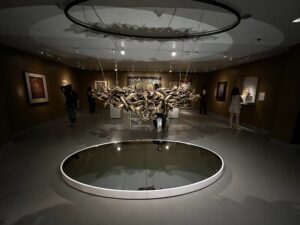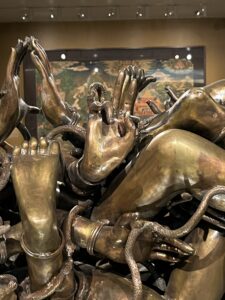My trip to the Rubin Museum of Art was filled with so many eye-opening and interesting experiences. However, the art definitely grew even further on me as I write this blog post and reflect on what interested me the most. At first, I was very unsure of what to expect. I specifically chose the Rubin with the knowledge of its closing on October 6th, so I knew I had to go take the opportunity to see it one last time. As soon as I walked in and bought my ticket, I noticed the museum’s popularity immediately as it was substantially busy. I did no prior research as to what art pieces the museum held, so I went in with a very open mindset in what I was about to experience and see!
EXHIBIT 1: MUTED EXPRESSIONS, TSHERIN SHERPA
I wanted to start with the exhibit that truly resonated with me the most: Muted Expressions by Tsherin Sherpa. The bronze statue represents so much more than what is shown to the eye. It represents the effects of a devastating earthquake Nepal faced in April of 2015. At first glance, I was impressed by the size of the art, yet confused about why it was such a vocal point to the room.
 An employee of the museum approached my sister and me, explained the statue’s story, and pointed out the most intricate details only the trained eye could see. The employee explained the “rock on” and “peace” symbols shown in the front and back of the statue among the traditional hand poses in Hinduism and Buddhism. Seeing the employee’s passion for art truly inspired me to learn more about the Himalayan culture and how artists could incorporate both modern and traditional aspects of their respective backgrounds. I saw an example of this as well with a statue called the “Uber Rat,” in which the Buddhist sacred animal, the rat, is wearing headphones while looking like a yellow NYC taxi cab. All in all, learning about the inspiration and story behind a piece of art, however meaningful it actually is, truly transforms the image and offers a new perspective of a piece of art that one may have never come up with beforehand.
An employee of the museum approached my sister and me, explained the statue’s story, and pointed out the most intricate details only the trained eye could see. The employee explained the “rock on” and “peace” symbols shown in the front and back of the statue among the traditional hand poses in Hinduism and Buddhism. Seeing the employee’s passion for art truly inspired me to learn more about the Himalayan culture and how artists could incorporate both modern and traditional aspects of their respective backgrounds. I saw an example of this as well with a statue called the “Uber Rat,” in which the Buddhist sacred animal, the rat, is wearing headphones while looking like a yellow NYC taxi cab. All in all, learning about the inspiration and story behind a piece of art, however meaningful it actually is, truly transforms the image and offers a new perspective of a piece of art that one may have never come up with beforehand.


(Different perspectives and details of the instillation)
EXHIBIT 2: COMPASSION, Jasmine Rajbhandari
Out of all of the paintings in one specific area of the museum, I was immediately drawn to Compassion the most. The red figures against the stark yellow background were extremely eye-catching and unique from a lot of the tapestries that were surrounding it. This painting’s visual aesthetic really intrigued me more than other aspects, and I really loved the vibrant colors of the paint. Looking closer, I saw the artist’s technique and how they strategically painted the yellow surrounding the figures in the painting. I remember admiring the effort and accuracy it must have taken to use such a bold color to surround the very intricate figures. After reading the description, the painting was about a Buddhist tradition called the Panchadan Festival that centered on men helping women and children during a war. Instead of representing human men assisting the women, the red figures in the painting actually represented the five Buddhist structures that would traditionally provide aid during times of war.
drawn to Compassion the most. The red figures against the stark yellow background were extremely eye-catching and unique from a lot of the tapestries that were surrounding it. This painting’s visual aesthetic really intrigued me more than other aspects, and I really loved the vibrant colors of the paint. Looking closer, I saw the artist’s technique and how they strategically painted the yellow surrounding the figures in the painting. I remember admiring the effort and accuracy it must have taken to use such a bold color to surround the very intricate figures. After reading the description, the painting was about a Buddhist tradition called the Panchadan Festival that centered on men helping women and children during a war. Instead of representing human men assisting the women, the red figures in the painting actually represented the five Buddhist structures that would traditionally provide aid during times of war.
EXHIBIT 3:
Lastly, the interactive exhibits were fascinating and entertaining. One exhibit that particularly stood out to me and my sister was the one related to scents. It was a fascinating and entertaining experience to be able to smell such specific scents coming out of machines. This reminded me of the way scents are pumped during rides at Disney to fully immerse the park guests, but in the case of the Rubin Museum, I was immersed in different scents and smells from regions worldwide. Some of the scents were unique and exotic, while others were familiar and welcoming. My favorite scent can be seen in the video with this link: IMG_7698 .
Conclusion:
All in all, the overall span of Himalayan culture represented in art is truly inspiring to see. At the Rubin, I saw Himalayan culture shown through gongs, scents, and even CGI characters. It truly opens your eyes to life outside of Western culture and the values that other cultures and religions hold. Referring back to what I said in the beginning, I recognized the art’s true meaning when I was able to see the blend of Western and Himalayan culture that the exhibits at the Rubin held. As I learn more about the culture and story behind the exhibits shown above, the exhibits become more significant and hold an even deeper value. It is such a unique experience to be entirely surrounded by Himalayan artwork and culture in the middle of one of the world’s most bustling cities. I am so disappointed that I only learned about the Rubin due to its closing, however, my great experience has inspired me to further my journey in improving my knowledge of art. At the end of my visit, I wrote an inspirational message on a prayer flag that represented one of five Buddhist elements, which will be hung on the day the Rubin closes.


